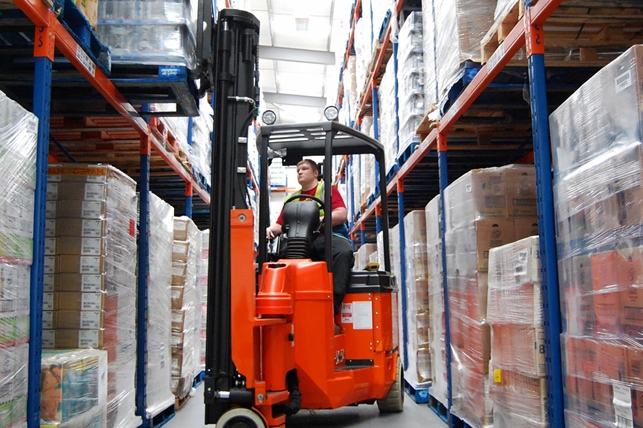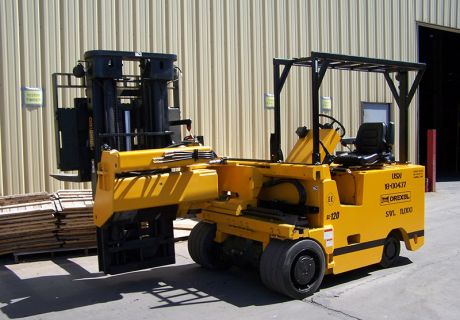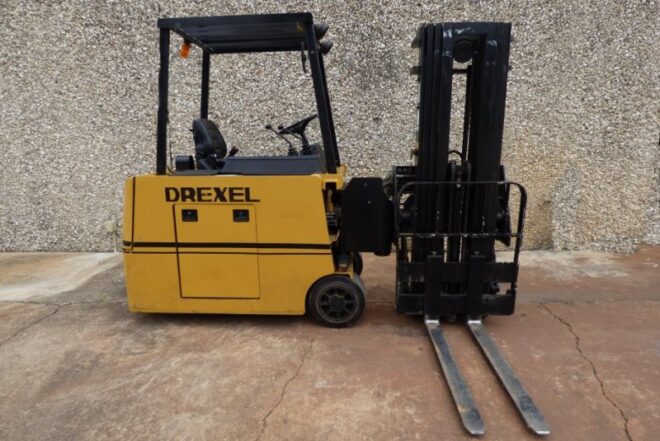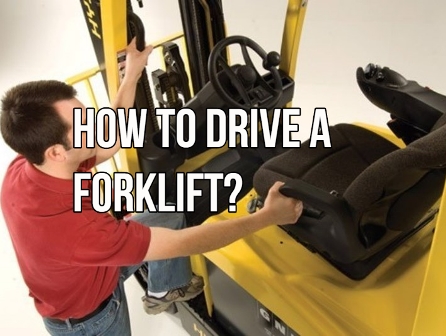Swing Mast Forklift: Maximize storage space with articulated or swing mast forklifts. The innovative design allows these lift trucks to do the work of a standard reach truck in aisles up to 40 inches smaller. These specialty forklifts are ideal for any application, both indoors or outdoors, where space to maneuver is limited.
Articulated & swing mast forklifts can help you get the most out of your warehouse storage space, but there are other ways to optimize your warehouse design to ensure optimal efficiency.

Narrow aisle forklift
This unit is specially designed for a very narrow aisles operation. Because it will turn sharply to the right (90 degrees) and can use it for your material handling without turning the whole forklift to the rack shelf/mesh direction.
You can simply drive this machine to the aisle (even in the narrow aisle as narrow as 6’/2 meters) and start working with its 90 degrees turn to the right easily. You can also use it for loading and unloading trucks if required. You can drive this machine outside also…but only of good days (no rain or snow ).

Very narrow aisle forklift
If your warehouse has building support columns in the aisles, the Narrow Aisle Forklift is much more maneuverable than a turret truck, and additional pallet positions are regained.
New operators will find that it’s easier to learn to operate an articulated forklift than it is to learn to operate more complicated turret forklifts.
This is because narrow forklift requires fewer controls. The Very Narrow Aisle Forklift has the same number of hydraulic controls as most conventional forklifts, and in similar locations as conventional forklifts.
In order to limit the amount of sway in the mast at higher lift heights, turret, Drexel and swing reach trucks typically require much flatter floor tolerances than conventional concrete floors, according to the Design and Construction of Concrete Floors.
These floors are much more expensive as a result. In addition, to flatter floors, most systems require the use of expensive embedded guidance systems and guide rails.
Because the front end of the Flexi pivots, the load remains stable even on rough floors. This eliminates the need for flat floors and the added expense of guidance systems and rails.

Articulated forklift truck
Your investment in an articulated forklift will normally be about 50% of the cost of a turret truck. But your savings don’t stop there.
A turret truck “system” often requires very expensive flat floors, wire guidance systems, and/or rails on the floor. This adds substantially to the cost of the basic truck. An articulated forklift truck needs none of this. The cost of the articulated forklift is the cost of the system.
Using an articulated forklift very narrow aisle forklift will typically yield 85% to 90% of the number of pallet positions when compared to turret and swing reach trucks in the same amount of space. But the intersecting aisle required by a turret truck is about twice that of an articulated forklift, so some pallet positions are regained as a result.

Swing Mast Forklift
Very narrow aisle forklifts will typically store 15% to 20% more pallet positions than a reach truck can store in the same amount of space. This will significantly lower your cost per pallet position.
It’s much easier for a conventional truck operator to learn to operate an articulated forklift than it is to learn to operate a reach truck because the overall truck design and hydraulic levers are the same as conventional forklifts.
An articulated forklift cost about 20% less to maintain than reach trucks. Most people will agree that maintenance expense is directly proportional to the number of moving parts. An articulated forklift has much fewer moving parts than a reach truck, and the parts are located where they are easier to access on an articulated forklift when service is required. The reach mechanism requires a lot of maintenance.
An articulated forklift operator can see the load being handled better than a reach truck operator can see his load. This is because the articulated forklift operator will pick and place loads at a 90° angle to the machine. Visibility from the side is unobstructed when compared to a reach truck operator trying to see through the mast and reach mechanism. In fact, reach truck operators can often be seen leaning outside of the operator’s compartment to get a better view of the forks or the load being handled.
The most read

How to drive a Forklift?
Forklift safety is of the utmost importance, and driving a forklift improperly presents various risks to both yourself and others, as well as your surroundings and the things you’re lifting.

How to operate a stand-up forklift?
Two main ways of operating a forklift exist. Operating while sitting down, and operating while standing up.
